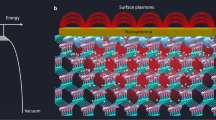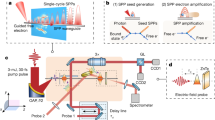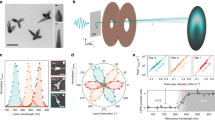Abstract
Surface plasmons offer the exciting possibility of improving the functionality of optical devices through the subwavelength manipulation of light. We show that surface plasmons can be used to shape the beams of edge-emitting semiconductor lasers and greatly reduce their large intrinsic beam divergence. Using quantum cascade lasers as a model system, we show that by defining a metallic subwavelength slit and a grating on their facet, a small beam divergence in the laser polarization direction can be achieved. Divergence angles as small as 2.4° are obtained, representing a reduction in beam spread by a factor of 25 compared with the original 9.9-µm-wavelength laser used. Despite having a patterned facet, our collimated lasers do not suffer significant reductions in output power (∼100 mW at room temperature). Plasmonic collimation provides a means of efficiently coupling the output of a variety of lasers into optical fibres and waveguides, or to collimate them for applications such as free-space communications, ranging and metrology.
This is a preview of subscription content, access via your institution
Access options
Subscribe to this journal
Receive 12 print issues and online access
$209.00 per year
only $17.42 per issue
Buy this article
- Purchase on Springer Link
- Instant access to full article PDF
Prices may be subject to local taxes which are calculated during checkout





Similar content being viewed by others
References
Lee, A. W. M. et al. High-power and high-temperature THz quantum-cascade lasers based on lens-coupled metal–metal waveguides. Opt. Lett. 32, 2840–2842 (2007).
Amanti, M. I., Fischer, M., Walther, C., Scalari, G. & Faist, J. Horn antennas for terahertz quantum cascade lasers. Electron. Lett. 43, 573–574 (2007).
Troccoli, M., Gmachl, C., Capasso, F., Sivco, D. L. & Cho, A. Y. Mid-infrared (λ ≈ 7.4 µm) quantum cascade laser amplifier for high-power single-mode emission and improved beam quality. Appl. Phys. Lett. 80, 4103–4105 (2002).
Nähle, L., Semmel, J., Kaiser, W., Höfling, S. & Forchel, A. Tapered quantum cascade lasers. Appl. Phys. Lett. 91, 181122 (2007).
Mühlschlegel, P., Eisler, H. -J., Martin, O. J. F., Hecht, B. & Pohl, D. W. Resonant optical antennas. Science 308, 1607–1609 (2005).
Cubukcu, E., Kort, E. A., Crozier, K. B. & Capasso, F. Plasmonic laser antenna. Appl. Phys. Lett. 89, 093120 (2006).
Yu, N. et al. Plasmonic quantum cascade laser antenna. Appl. Phys. Lett. 91, 173113 (2007).
Yu, N. et al. Bowtie plasmonic quantum cascade laser antenna. Opt. Express 15, 13272–13281 (2007).
Lezec, H. J. et al. Beaming light from a subwavelength aperture. Science 297, 820–822 (2002).
Martín-Moreno, L., García-Vidal, F. J., Lezec, H. J., Degiron, A. & Ebbesen, T. W. Theory of highly directional emission from a single subwavelength aperture surrounded by surface corrugations. Phys. Rev. Lett. 90, 167401 (2003).
Baida, F. I., Labeke, D. V. & Guizal, B. Enhanced confined light transmission by single subwavelength apertures in metallic films. Appl. Opt. 42, 6811–6815 (2003).
Akarca-Biyikli, S. S., Bulu, I. & Ozbay, E. Enhanced transmission of microwave radiation in one-dimensional metallic gratings with subwavelength aperture. Appl. Phys. Lett. 85, 1098–1100 (2004).
Yu, L.-B. et al. Physical origin of directional beaming emitted from a subwavelength slit. Phys. Rev. B 71, 041405(R) (2005).
Kim, S., Kim, H., Lim, Y. & Lee, B. Off-axis directional beaming of optical field diffracted by a single subwavelength metal slit with asymmetric dielectric surface gratings. Appl. Phys. Lett. 90, 051113 (2007).
Guo, B., Song, G. & Chen, L. Plasmonic very-small-aperture lasers. Appl. Phys. Lett. 91, 021103 (2007).
Gao, J., Song, G., Gan, Q., Guo, B. & Chen, L. Surface plasmon modulated nano-aperture vertical-cavity surface-emitting laser. Laser Phys. Lett. 4, 234–237 (2007).
Hirohata, T., Niigaki, M., Mochizuki, T., Fujiwara, H. & Kan, H. Near-infrared photocathode using surface plasmon resonance. Jpn J. Appl. Phys. 46, 630–632 (2007).
Novotny, L. & Hecht, B. Principles of Nano-Optics (Cambridge Univ. Press, Cambridge, 2006).
Stutzman, W. L. & Thiele, G. A. Antenna Theory and Design (John Wiley & Sons, New York, 1981).
Pflügl, C. et al. Single-mode surface-emitting quantum-cascade lasers. Appl. Phys. Lett. 86, 211102 (2005).
López-Tejeira, F. et al. Efficient unidirectional nanoslit couplers for surface plasmons. Nature Phys. 3, 324–328 (2007).
Hofstetter, D. et al. Continuous wave operation of a 9.3 µm quantum cascade laser on a Peltier cooler. Appl. Phys. Lett. 78, 1964–1966 (2001).
Acknowledgements
We acknowledge support from the Air Force Office of Scientific Research (AFOSR MURI on Plasmonics) and the Harvard Nanoscale Science and Engineering Centre (NSEC). This work was performed in part at the Centre for Nanoscale Systems (CNS) at Harvard University, a member of the National Nanotechnology Infrastructure Network (NNIN), which is supported by the National Science Foundation under NSF award no. ECS-0335765. CNS is part of the Faculty of Arts and Sciences at Harvard University. We would like to thank H. Mosallaei for helpful discussions and suggestions. We acknowledge the contributions of R. Blanchard in the preliminary simulations of the ring-shaped collimators.
Author information
Authors and Affiliations
Corresponding author
Supplementary information
Supplementary Information
Supplementary Figures S(1)a–S(1)c (PDF 175 kb)
Rights and permissions
About this article
Cite this article
Yu, N., Fan, J., Wang, Q. et al. Small-divergence semiconductor lasers by plasmonic collimation. Nature Photon 2, 564–570 (2008). https://doi.org/10.1038/nphoton.2008.152
Received:
Accepted:
Published:
Issue Date:
DOI: https://doi.org/10.1038/nphoton.2008.152
This article is cited by
-
Ultra-low threshold lasing through phase front engineering via a metallic circular aperture
Nature Communications (2022)
-
Optical Anisotropy in van der Waals materials: Impact on Direct Excitation of Plasmons and Photons by Quantum Tunneling
Light: Science & Applications (2021)
-
Two-fluid, hydrodynamic model for spherical electrolyte systems
Scientific Reports (2018)
-
Wide Field-of-view and Broadband Terahertz Beam Steering Based on Gap Plasmon Geodesic Antennas
Scientific Reports (2017)
-
Metasurface electrode light emitting diodes with planar light control
Scientific Reports (2017)



